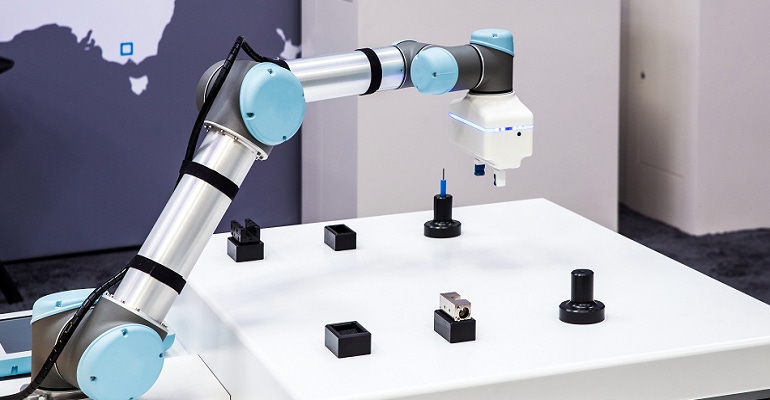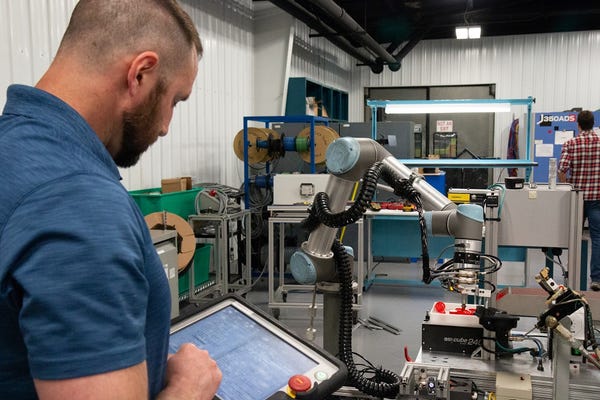Industry Voices: Universal Robots Discusses how to Solve Your Labor and Productivity Challenges With Cobots
Joe Campbell from Universal Robots explains why cobots are gaining in popularity.
May 18, 2021

Something unusual happened during the pandemic. Instead of freezing their automation plans, a good portion of manufacturers accelerated the process. The seeming standstill was a call to arms for automated production. Social distancing limited production workers. Labor shortages created the need for changing traditional production methods. It all added up to a need for more automation.
We caught up with Joe Campbell, senior manager of applications development at Universal Robots, to get his take on the status of robots in manufacturing.
Design News: What challenges that are prompting your customers to invest in robotics? Labor shortages? Pandemic-related social distancing?
Joe Campbell: The number one challenge we see in manufacturing today is labor – manufacturing labor. The latest report from the Bureau of Labor and Statistics shows 475,000 active unfilled job openings in manufacturing, and the National Association of Manufacturers reports attracting and retaining a qualified workforce is the number one issue for their members. The problem is not going to go away as 27% of the manufacturing workforce is 55 or older and due to retire in the next decade. Younger generations are not interested in manufacturing, particularly the Dull Dirty and Dangerous jobs of the past.

We also see an overall drive to increase productivity as a means to manage business challenges beyond labor. Increasing productivity will support top-line growth, capacity to add new customers (and keep current customers!) while managing the labor crisis. Increasing productivity will also help defer or minimize large capital investments in equipment or facilities. And finally, increased productivity improves operational performance and bottom-line results with reduced overtime and better machine utilization.
Design News: Are end-effector developments affecting what cobots can do?
Joe Campbell: Universal Robots has a unique relationship with end effector suppliers, as well as process solution providers. The program is called UR+, and it is a deep commercial and technical relationship for the development of true plug-n-play (or plug-n-produce) peripherals, accessories, and solution kits for UR robots. The end-user benefits from the UR+ program, as the overall objective is to reduce the time, cost, and risk of deploying automation. UR+ certified products achieve this with fully validated mechanical, electrical, and software compatibility that delivers on the plug-n-produce promise.
Design News: What is the single most pressing barrier to robot adoption, and how do you overcome that barrier?
Joe Campbell: The number one issue we see again and again is a lack of understanding of collaborative technology, and how cobots are re-shaping automation investments and returns. In companies large and small, the view of robotic automation has been shaped over the past 50 years: expensive, difficult to program, long lead times, long deployment times, difficult to re-deploy, and requiring dedicated robot specialists to implement and support. Collaborative robots break that model at every turn, and our challenge is to continue to educate the manufacturing community on how cobots can re-shape their businesses.
The problem is particularly acute in small and medium enterprises, a segment that has historically been underserved by traditional automation. Companies too small to warrant a sales call from a traditional automation provider are buying and integrating collaborative robots at an increasing pace.
Design News: What developments do you expect with cobots in the next few years? Cobots attached to mobile robots? The ability to lift heavier payloads?
Joe Campbell: Mobility is key to many application segments and will drive new developments in programming, connectivity, communications, and power. And as control systems and safety sensors get more capable, we will see growth in reach and payload. But I think the biggest innovation will be the growth of UR+ Application Kits, and hardware and software working seamlessly together to solve specific applications. We are seeing this today in all application segments, from machine tending to palletizing, welding to a screwdriver, and everything in between. Application Kits solve real application challenges with easy-to-deploy out-of-the-box solutions at very low price points.
Design News: How are integration issues evolving for cobots? Are our customers increasingly interested in making cobots part of a larger automation system?
Joe Campbell: We do see collaborative automation co-existing with traditional automation, but rarely. Typically, the shift to collaborative is complete, and there is little motivation to inter-mingle. Exceptions would be in specific application segments such as injection molding, where platen mounted cartesian robots pull parts out of a mold, and cobots perform secondary operations.
Rob Spiegel has covered manufacturing for 19 years, 17 of them for Design News. Other topics he has covered include automation, supply chain technology, alternative energy, and cybersecurity. For 10 years, he was the owner and publisher of the food magazine Chile Pepper.
About the Author(s)
You May Also Like




